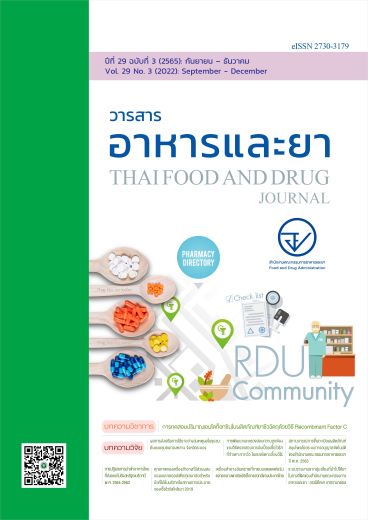สถานการณ์การขึ้นทะเบียนผลิตภัณฑ์สมุนไพรด้วยระบบการอนุญาตอัตโนมัติของสำนักงานคณะกรรมการอาหารและยาปี พ.ศ. 2563
Main Article Content
บทคัดย่อ
ความสำคัญ: สำนักงานคณะกรรมการอาหารและยา (อย.) ได้เปิดใช้งานระบบขึ้นทะเบียนตำรับผลิตภัณฑ์สมุนไพรแบบอ้างอิงตำรับแบบอัตโนมัติเมื่อวันที่ 14 กุมภาพันธ์ 2563 ดังนั้นการทราบถึงสถานการณ์การขึ้นทะเบียนอัตโนมัติจะทำให้สามารถปรับปรุงระบบให้มีประสิทธิภาพยิ่งขึ้น
วัตถุประสงค์: เพื่อศึกษาสถานการณ์ความครบถ้วนและถูกต้องของทะเบียนตำรับผลิตภัณฑ์สมุนไพรแบบอ้างอิงตำรับผ่านระบบการอนุญาตอัตโนมัติของ อย. และศึกษาปัญหาการใช้งานผ่านระบบการอนุญาตแบบอัตโนมัติของผู้ประกอบการที่ได้รับอนุญาต
วิธีการวิจัย: เป็นการวิจัยเชิงพรรณนา เก็บข้อมูลการขึ้นทะเบียนแบบย้อนหลัง (retrospective study) ช่วงวันที่ 14 กุมภาพันธ์ - 31 ธันวาคม 2563 จากฐานข้อมูลการขึ้นทะเบียนตำรับผลิตภัณฑ์สมุนไพรของ อย. และใช้แบบสอบถามปัญหาการใช้งานระบบการอนุญาตผลิตภัณฑ์สมุนไพรแบบอัตโนมัติ โดยสุ่มเก็บตัวอย่างแบบบังเอิญจำนวน 15 ตัวอย่าง จากประชากรผู้ประกอบการที่ได้รับอนุญาตในช่วงดังกล่าว 30 ตัวอย่าง
ผลการศึกษา: ข้อมูลการขึ้นทะเบียนตำรับผลิตภัณฑ์สมุนไพรแบบอ้างอิงตำรับด้วยระบบการอนุญาตอัตโนมัติของ อย. ทั้งหมด 91 ทะเบียน พบว่าทะเบียนที่ได้รับอนุญาตในระบบมีความครบถ้วนและถูกต้องตามเงื่อนไขกำหนดทุกรายการ ร้อยละ 2.20 โดยพบว่ามี 1 รายการที่ทุกทะเบียนส่งครบถ้วนคือ ฉลากและเอกสารกำกับผลิตภัณฑ์ ส่วนที่ไม่ครบถ้วน 3 ลำดับแรก ได้แก่ คำรับรองเงื่อนไขการขึ้นทะเบียนตามบัญชียาจากสมุนไพรที่แนบท้ายบัญชียาหลักแห่งชาติที่เป็นเภสัชตำรับโรงพยาบาล ผลตรวจวิเคราะห์สารสำคัญ และคำรับรองเงื่อนไขการแจ้งรายการเรียกเก็บยาคืน ร้อยละ 75.00, 73.08 และ 42.86 ตามลำดับ ทะเบียนผลิตภัณฑ์ที่มีเอกสารหรือข้อมูลไม่ครบถ้วน 3 ลำดับสูงสุด คือ ยาชง ฟ้าทะลายโจรชนิดแคปซูล และยาหม่อง ร้อยละ 100.00, 80.00 และ 58.82 ตามลำดับ สำหรับความไม่ถูกต้องของข้อมูลทะเบียนเมื่อเทียบปริมาณทะเบียนในสัดส่วนใกล้เคียงกัน 3 ลำดับแรก พบว่า วิธีการผลิต คำรับรองสำหรับผู้รับอนุญาตที่ยื่นคำขอขึ้นทะเบียนตำรับยาแผนโบราณสำหรับการรายงานอาการไม่พึงประสงค์จากยาชนิดร้ายแรง และคำรับรองเงื่อนไขการแจ้งรายการเรียกเก็บยาคืนของผู้รับอนุญาต ไม่ถูกต้องร้อยละ 54.44, 40.98 และ 38.46 ตามลำดับ และเมื่อศึกษารายละเอียดของข้อมูลบนฉลากที่แจ้งไว้พบว่าส่วนใหญ่ไม่ถูกต้องในหัวข้อชื่อและปริมาณสารสำคัญ ชื่อผลิตภัณฑ์ และสรรพคุณ/ข้อบ่งใช้ ร้อยละ 47.13, 26.14 และ 22.99 ตามลำดับ ส่วนข้อมูลของเอกสารกำกับผลิตภัณฑ์ พบว่า ขนาดและวิธีการใช้ ชื่อและปริมาณที่เป็นสารสำคัญ และชื่อผลิตภัณฑ์ ไม่ถูกต้องมากที่สุด ร้อยละ 54.55, 46.59 และ 25.00 ตามลำดับ นอกจากนั้น มีกลุ่มตัวอย่างร้อยละ 60 ระบุว่าในช่วงเวลาดังกล่าวพบปัญหาการใช้งานระบบอัตโนมัติ เฉลี่ยโดยรวม 1.54 ครั้ง ส่วนใหญ่พบว่าระบบผิดพลาดไม่สามารถบันทึกข้อมูลได้ และการอัปโหลดเอกสารแนบไม่ได้ เป็นปัญหาเท่ากัน ร้อยละ 46.67 รองลงมาคือระบบไม่พร้อมใช้งาน/ระบบปิด ร้อยละ 40.00 กรอกข้อมูลไม่ได้ และระบบผิดพลาดบันทึกเอกสารที่อัปโหลดไม่ได้ ร้อยละ 33.33
สรุป: ระบบการอนุญาตอัตโนมัติที่ใช้ในการขึ้นทะเบียนตำรับผลิตภัณฑ์สมุนไพรแบบอ้างอิงตำรับ สามารถคัดกรองข้อมูลให้ครบถ้วนและถูกต้องได้ ร้อยละ 2.20 ผู้ใช้งานส่วนใหญ่พบปัญหาการใช้งานที่เกิดจากระบบอัตโนมัติ ทั้งนี้ ทะเบียนที่ไม่ถูกต้องครบถ้วนในช่วงเวลาดังกล่าวได้แจ้งผู้ประกอบการให้แก้ไขทะเบียนให้ถูกต้องเพื่อควบคุมความเสี่ยงแล้ว ดังนั้นเพื่อเพิ่มประสิทธิภาพระบบการอนุญาตอัตโนมัติ ควรให้ผู้ที่พบปัญหาข้อมูลการอนุญาตทำงานร่วมกับผู้ออกแบบระบบเพื่อออกแบบระบบการอนุญาตใหม่ และเพื่อลดผลกระทบ ในช่วงปรับปรุงระบบการอนุญาต อย. ควรปรับลดขั้นตอนการแจ้งข้อมูลและลดเอกสารบางรายการที่ต้องยื่นผ่านระบบ เพิ่มขั้นตอนการตรวจสอบเอกสารโดยเจ้าหน้าที่ก่อนการอนุญาตขึ้นทะเบียนตำรับผลิตภัณฑ์สมุนไพร และควรตรวจสอบเฝ้าระวังผลิตภัณฑ์ที่วางจำหน่ายในท้องตลาด และจัดการปัญหาผลิตภัณฑ์ผิดกฎหมายอย่างเข้มงวด เพื่อการบริโภคผลิตภัณฑ์ที่มีคุณภาพ ปลอดภัย ได้มาตรฐาน
Article Details

อนุญาตภายใต้เงื่อนไข Creative Commons Attribution 4.0 International License.
เอกสารอ้างอิง
พระราชบัญญัติผลิตภัณฑ์สมุนไพร พ.ศ. 2562. ราชกิจจานุเบกษา เล่มที่ 136, ตอนพิเศษ 56 ก (ลงวันที่ 30 เมษายน 2562).
สำนักงานคณะกรรมการอาหารและยา. ศูนย์รวมข้อมูลเพื่อติดต่อราชการ : การขึ้นทะเบียนตำรับยาแผนโบราณ [อินเทอร์เน็ต]. [เข้าถึงเมื่อ 29 พ.ย. 2564]. เข้าถึงได้จาก: https://www.info.go.th/#!/th/search/77465/ยาแผนโบราณ/
กองผลิตภัณฑ์สมุนไพร สำนักงานคณะกรรมการอาหารและยา. แนวทางการขึ้นทะเบียนผลิตภัณฑ์สมุนไพรที่เป็นแบบการอ้างอิงตำรับ [อินเทอร์เน็ต]. นนทบุรี: กองผลิตภัณฑ์สมุนไพร; 2563 [เข้าถึงเมื่อ 29 พ.ย. 2564]. เข้าถึงได้จาก: https://drive.google.com/file/d/18kP4Qk6qu6D6e3wuloMuS4TQwiRuGCz7/view
กองผลิตภัณฑ์สมุนไพร สำนักงานคณะกรรมการอาหารและยา. คู่มือการเตรียมเอกสารสำหรับการยื่นคำขอขึ้นทะเบียนผลิตภัณฑ์สมุนไพร (ยาจากสมุนไพร) ที่เป็นแบบการอ้างอิงตำรับ [อินเทอร์เน็ต]. นนทบุรี: กองผลิตภัณฑ์สมุนไพร; 2563 [เข้าถึงเมื่อ 29 พ.ย. 2564]. เข้าถึงได้จาก: https://drive.google.com/file/d/1Ul8LYqsctFHcK8wsipY2kTQ8LCJ0dgUO/view
กองผลิตภัณฑ์สมุนไพร สำนักงานคณะกรรมการอาหารและยา. คู่มือระบบ E-Permission ผลิตภัณฑ์สมุนไพร ยาจากสมุนไพร ผ่านเว็บไซต์ privus.fda.moph.go.th [อินเทอร์เน็ต]. นนทบุรี: กองผลิตภัณฑ์สมุนไพร; 2563 [เข้าถึงเมื่อ 29 พ.ย. 2564]. เข้าถึงได้จาก: https://drive.google.com/file/d/1OzOYbWNm1m8iS_8ma9VQ8hXmfmQuroR4/view
มูลนิธิภิวัฒน์สาธารณสุขไทย. แนะ อย.ยกเลิกจดแจ้งเครื่องสำอางออนไลน์ ลดปัญหาเครื่องสำอางผิดกฎหมาย [อินเทอร์เน็ต]. อุดรธานี: มูลนิธิภิวัฒน์สาธารณสุขไทย; 2561 [เข้าถึงเมื่อ 3 มกราคม 2564]. เข้าถึงได้จาก : https://www.hfocus.org/content/2018/04/15738
อภิษฐา ทรัพย์ประเสริฐ, จันทรรัตน์ สิทธิวรนันท์. การประเมินความคลาดเคลื่อนภายหลังออกสู่ตลาดของผลิตภัณฑ์เครื่องสำอางที่ได้รับการจดแจ้งโดยระบบการจดแจ้งอัตโนมัติ. วารสารอาหารและยา 2562;26(1):23-35.
สำนักงานคณะกรรมการกฤษฎีกา. พระราชบัญญัติยา พ.ศ. 2510. ราชกิจจานุเบกษา เล่มที่ 136, ตอนที่ 50 ก (ลงวันที่ 16 เมษายน 2562).
สำนักยา สำนักงานคณะกรรมการอาหารและยา. คู่มือหลักเกณฑ์การขึ้นทะเบียนตำรับยาแผนโบราณ [อินเทอร์เน็ต]. นนทบุรี: สำนักยา; 2561 [เข้าถึงเมื่อ 12 พ.ย. 2564]. เข้าถึงได้จาก: https://www.fda.moph.go.th/Herbal/SitePages/Document/manual/หลักเกณฑ์/1.คู่มือหลักเกณฑ์การขึ้นทะเบียนตำรับยาแผนโบราณ.pdf
เกษรา จันทรวงศ์ไพศาล, ชิดชนก เรือนก้อน. สถานการณ์การรับจดแจ้งเครื่องสําอางด้วยระบบ e-Submission และการกํากับดูแลของสํานักงานคณะกรรมการอาหารและยา ปีงบประมาณ พ.ศ. 2559-2562. วารสารอาหารและยา 2564;28(1):60-71.
ไชยวิชิต ไชยสิทธิ์, กนกพร ธัญมณีสิน. การควบคุมและกำกับผลิตภัณฑ์เสริมอาหารที่ได้รับอนุญาตผ่านระบบ E-submission: กรณีศึกษาในภาคตะวันออกเฉียงเหนือ. วารสารเภสัชกรรมไทย 2562;11(2):397-410.


